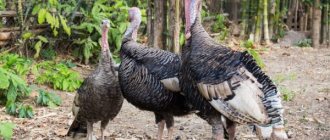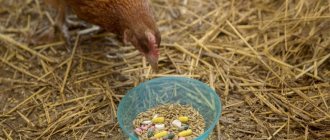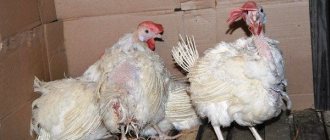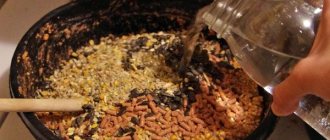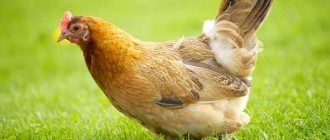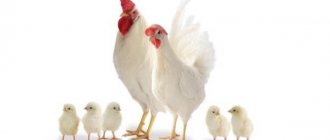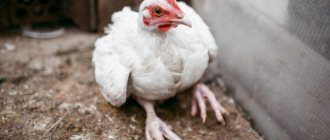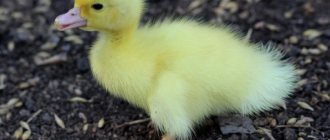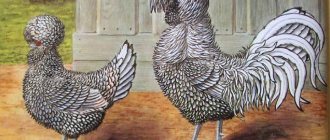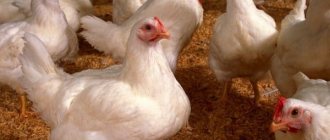Chickens, like other poultry, are susceptible to various infectious and viral diseases. To identify the disease at the initial stage, carefully observe the behavior of your charges. It happens that in the poultry house some chickens fall on their feet and do not get up. This is a clear sign that without your help and appropriate treatment, the chicken will die.
general information
Of course, those farmers who have been involved in poultry farming for several years are already familiar with this problem and have an idea of how to treat chickens; they do not panic. But a novice farmer has a hard time: you can literally fall into a stupor, especially if the pathology “suddenly” affects several individuals at once.
Let us note that whatever the reason, damage to the farm will be caused in any case: and the more birds affected, the more noticeable the damage.
Chickens' egg production decreases, and those eggs that appear are often fragile and have a thin shell. In addition, treatment costs can be significant, and bird numbers are sometimes significantly reduced.
Chickens can fall on their feet and limp for various reasons, the most common of which are the following:
- critical lack of vitamins and beneficial microelements in the poultry menu;
- tendon inflammation, arthritis, rickets;
- other diseases;
- injuries, wounds and cuts;
- keeping poultry in improper conditions.
Next, we will go through all the points in detail and find out how to identify each of the causes and how to treat birds.
Lack of nutrients in the diet
The most common cause of pathology for which chickens fall on their feet. If birds are lacking important nutrients, it is not surprising that they fall on their feet.
Despite the apparent mildness of vitamin deficiency, in the case of birds it can lead to quite serious consequences, including fatal ones. The danger is also that the lack of vitamins affects all livestock without exception: all birds suffer equally.
Symptoms of vitamin deficiency in chickens include:
- weakness, immobility of livestock;
- poor appetite;
- pale skin;
- slow growth, poor development;
- chicks' feathering is delayed;
- visual impairment;
In addition, the lack of vitamins also affects the respiratory system: birds breathe frequently, gasp for air with their beaks, and sometimes poultry farmers see a bird fall unexpectedly, including on a flat floor.
Fortunately, the situation has not yet taken on irreversible forms; it is quite simple to correct it: you just need to fill the chickens’ diet with useful microelements and vitamins, and include mineral supplements.
What to do?
It is recommended to give birds liquid vitamins A and E, as well as fish oil rich in essential microelements. Add vitamins to regular food, from where it is guaranteed to get into the birds' bodies. You can easily purchase these vitamins at a regular pet store, or order them from an online store.
To make your birds’ diet more fortified and healthy, include the following components:
- beets and carrots;
- cabbage;
- bone meal;
- sprouted grain.
Fresh herbs also perfectly compensate for the lack of vitamins.
Rickets
More often, rickets affects young chickens, not adults. The disease is also called D-hypovitaminosis. As a result of the developing pathology, the skeletal skeleton of the birds weakens, the limbs also weaken, and the chicken falls on its feet.
If a chicken has developed rickets, it will fall on its legs because its bones and skeleton are too fragile. If rickets is not treated, its complication, osteomyelitis, may develop. Death is also likely due to severe softening of skeletal tissue.
A sign can be not only the bird falling to its feet, but also a stop in laying eggs.
Also, with rickets, the following symptoms are very likely:
- loss of appetite in birds;
- weakness and lethargy;
- loss of pomp and decorativeness in feathers;
- weakness of the paws (the same condition when “the legs cannot bear”);
- movements are unbalanced, coordination is impaired;
It is advisable to begin treating rickets at the first signs - many more serious problems can then be avoided.
What to do?
Treatment of avian rickets should be comprehensive:
- It is necessary for the chicken to spend a lot of time in the sun, under the influence of which its body produces vitamin D and strengthens its bones.
- Adding vitamin D to the food in the form of liquid or oil will also do a good job.
- It is necessary to add microelements such as calcium and phosphorus to the diet.
- Intensive vitamin therapy with a predominance of vitamin D and heating the birds in ultraviolet light will undoubtedly be beneficial.
If rickets is in the initial stage, the above measures can cure the bird completely. But if osteomyelitis has already begun to develop, this leads to irreversible deformation of the limbs. And even after complete recovery, the defect is not eliminated.
How to treat broilers that fall on their feet
Many farmers face problems when raising poultry. Why do broilers fall on their feet? Why do chickens sit on their feet and die? We will analyze the most famous culprits of the disease and suggest the best ways to get rid of them.
Broilers fall to their feet and sit
Rickets
Vitamin D deficiency is the most common cause and treatment will help get the bird back on its feet. The disease occurs during acute hypovitaminosis and affects both young animals and adults. Disruption of calcium and phosphorus metabolism provokes a deterioration in bone formation, so the chicken falls on its feet. The result is chronic weakening of the limbs, which also leads to deformation of the egg shell.
The main signs of rickets in chickens:
- decreased appetite;
- ruffled feathers;
- low mobility;
- lack of coordination.
If within three weeks the farmer does not pay attention to the manifestations of the disease, then the condition worsens. Due to a lack of calcium, the beak becomes soft to the touch
The final stage is characterized by complete loss of strength and death of the individual.
If adult chickens begin to lay eggs in soft or fragile shells, then this is a sign of a lack of vitamin D. The disease then affects the legs and bones, as a result of which the bird has difficulty getting up on its feet; broilers often fall. In laying hens, the laying process is disrupted. Therefore, knowing why chickens fall on their feet and how to treat them is the primary task of every breeder.
Arthritis
This disease of poultry is also popularly called “dirty foot disease.” This joint disease is of viral origin. In more rare cases, arthritis occurs as a result of an unbalanced, poor diet.
Viral arthritis is often called tenosynovitis. The causative agent of this dangerous disease is reovirus. In this case, the chicken will first begin to limp, then become almost motionless. A rupture of the shin bones and severe destruction of the cartilage tissue in the legs are likely.
The bird's appetite decreases, and the skin color becomes pale. Egg production and bird weight also decrease noticeably. Viral arthritis often develops as a complication after infectious diseases suffered by birds.
It is not difficult to detect the disease: you just need to carefully feel the bird’s joints. With arthritis, the joints will be noticeably inflamed, swollen, and hot to the touch.
Additional symptoms may include:
- pain in the legs of the bird;
- stiffness of movement, leading, among other things, to falls;
- complete failure of the legs is also possible - then the birds sit or lie down and practically do not move.
Note that this disease is dangerous and is difficult for chickens to tolerate. If the disease is not treated, inflammation from one joint will spread to others, expand, and go deeper into the tissue.
Thus, the acute phase of the disease turns into a chronic one. More often, adults suffer from arthritis; chickens are much less likely to suffer from arthritis.
What to do?
Arthritis needs to be treated urgently, as the disease progresses rapidly. Special antiviral drugs are prescribed.
Along with antivirals, antibiotic treatment is also indicated. The following drugs can be considered as suitable antibiotics for viral arthritis:
- Ampicillin;
- Sulfadimethoxine;
- Polymyxin M sulfate;
- Benzidepenicillin.
Give antibiotics to chickens for at least five days. Usually the course takes a week, but if the arthritis has progressed greatly, it can take longer. It is not advisable to self-medicate; it is recommended to show sick birds to a veterinarian.
They are also treated with folk remedies, which according to reviews are quite effective. So, some poultry farmers give sick chickens a drink of vodka: however, with this method it is important not to overdo it with the “treatment”. Otherwise, the bird will do more harm than good.
Preventive measures are also important to help minimize the likelihood of disease. To prevent chickens from getting arthritis, keep the room where they are kept clean. It is necessary to regularly clean cages and pens, and immediately isolate sick birds from others.
Multivitamins and green food will be very useful for arthritis.
Gout
Chickens may also be affected by this “disease of kings.” The cause of gout is the accumulation of salts and uric acid in the joints. The symptom of the disease is swollen and very hard-to-touch joints. Characteristic growths-bumps can be seen on the bird’s legs.
Birds endure gout hard: they walk little and poorly, sometimes they literally fall off their feet. Because movement causes pain, the chicken cannot be moved from its place.
Typically, the cause of the pathology is long-term feeding with mixed feed with a high content of meat and bone meal or fish meal. As a result of such nutrition, the metabolism in the bird's body is disrupted.
What to do?
It is necessary to balance the diet, remove excess feed with gout-provoking flour. It is advisable to switch laying hens to a diet with a predominance of whole and sprouted grains.
Pododermatitis
This disease can also lead to a chicken falling on its feet, and it occurs due to insufficient hygiene of cages and chicken coops.
Along with the bird falling on its feet, in this case the following symptoms appear:
- the skin on the paws becomes inflamed and may crack;
- visible wounds on the legs;
- the bird is limping;
- presses paws to body;
- The chicken's legs are hot to the touch, which indicates an inflammatory process occurring in them.
What to do?
It is necessary to increase the bird’s immunity by adding healthy vitamins and minerals to its diet, and also be sure to monitor hygiene in the room. Change the bedding in cages and nests more often, and remove droppings on time.
Inflamed paws should be thickly lubricated with fish oil or syntamicin ointment. Your veterinarian may also prescribe another anti-inflammatory drug.
Fall to your feet
If a chicken limps on one or two limbs, its joints are enlarged and swollen, its legs are damaged, the bird may fall when walking, or lie down without rising from one place.
As a preventative measure, it is recommended to regularly clean the chicken coop and equipment. Where chickens roam freely, you also need to ensure cleanliness.
The therapeutic measure would be to isolate the sick chicken from the flock. Wounds on the bird's legs will need to be treated with brilliant green or iodine. When arthritis or tenosynovitis is the cause of a bird falling on its feet, the birds are treated with antibiotic drugs (Sulfadimethoxine, Ampicillin or Penicillin) and anti-viral agents for 5 days, injections can be given, and they can be mixed with food.
Arthritis can also be treated with multivitamin supplements in chicken feed, tricalcium phosphate and greens in the daily menu. Frequent walking should take place if the season is warm; in the winter months, chickens should be released in favorable sunny weather or during thaws, when there are mild frosts, limiting only the time spent outside. Be sure to extend daylight hours with the help of lighting fixtures in the chicken coop.
Viral arthritis and staphylococci can only be cured by vaccination. The bird can be saved from pododermatitis by reviewing its feeding and cleaning the nesting areas and roosts of the chickens. The litter must laugh often. Chicken legs can be lubricated with fish oil or syntamic ointment.
Perosis is difficult to treat, and death among young animals is not uncommon. Adult chickens can survive if they are fed supplements with a large amount of vitamin groups B, P, magic, manganese and iodine should also be present in the feed.
In summer
In the summer, when the bird mostly walks free all day, the chicken may step on a piece of glass or nails in the yard, the resulting wound hurts and can fester, making it easier for the chickens to stand or fall down. If a careless chicken jumps from an excessively high perch, she may suffer a sprain or dislocate or break her leg.
in winter
The cold season is dangerous for almost all breeds of chickens, especially if they are not frost-resistant. Long winter walks or short ones, but in severe frost, harm the health of the chicken flock, which can easily catch a cold or frostbite on its feet while walking in the snow.
Insulated chicken coops with lighting and optimal air temperature are suitable for keeping chickens in winter.
Dry bedding on the floor is of no small importance; feet can freeze even when walking on a cold surface
Injuries
A chicken can suffer the following injuries, causing it to fall on its feet:
- fracture;
- rupture, tendon displacement;
- dislocation;
- a cut;
- sprain.
To rule out this cause, carefully examine the bird's limbs. It is also recommended to feel them. A cut can be detected immediately, but a fracture or dislocation requires a more detailed examination.
What to do?
If an injury is discovered, it is best to invite a veterinarian to examine the bird and make recommendations for treatment.
To prevent further injury, remove cutting, dangerous objects from the coop and run area. It is also recommended to keep aggressive birds that start fights in the yard separately.
And do not build a perch in the coop that is too high, as the bird may fall from it while sleeping and be injured. A height of 90 cm is quite enough.
Disease Prevention
In order to prevent illness in chickens and death of poultry, and also not to “rack your brains” in search of a suitable treatment (which, unfortunately, in some cases may not produce results), it is important to regularly prevent leg diseases, which will be much easier and more effective. Among the main methods of prevention are the following:
- Vaccination of chicks against incurable Marek's disease.
- Timely cleaning of the poultry house and maintaining cleanliness there will protect chickens from arthritis, pododermatitis and many other diseases.
- Sanitation of a chicken coop is disinfection after infected individuals, allowing to destroy harmful bacteria and viruses.
- To prevent rickets, chicks should be irradiated with UV lamps suspended at a height of three meters (initially half an hour, then increase the time to 5 hours).
- Low perches are also a measure to prevent injury, since a bird can fall from a great height and damage its paws.
Thus, the responsibility of the owner in caring for the bird will allow him to minimize the diseases of his “wards” and raise a healthy population of birds. The main thing is to provide them with a balanced diet that includes all the necessary elements, keep the chicken coop clean, and also detect “problems” in the health of the birds in time and respond to them immediately.
Scabies
This disease, which is not very dangerous for humans, in the avian environment can even lead to such serious consequences as falling on one’s feet.
Scabies is diagnosed quite simply, since in this case growths appear on the bird’s legs that an experienced veterinarian will not confuse with anything else. The causative agent of the disease is the scabies mite. The parasite is transmitted to birds from sick individuals, through a common feeder and bedding.
Symptoms of avian mange are as follows:
- Unsightly growths form on the paws, preventing the bird from walking and moving;
- a white coating is noticeable on the skin of the paws (“lime foot”, as people say);
- the chicken gets up extremely reluctantly and only as a last resort;
- the bird is inactive and lethargic.
What to do if the bird is debilitated by scabies?
Fortunately, scabies is the lesser evil in this case. Treating the disease is simple: the legs of affected individuals are treated with a strong solution of soap, and then with special anti-scabies preparations.
Perosis
In simple terms, perosis is nothing more than a displacement of the tendons. Most often, this disease affects broiler chickens that grow too quickly.
The disease occurs due to a lack of B vitamins and other valuable microelements in the diet. The symptom is the bird's paws, turned at an unnatural angle. Such an individual is not able to jump onto a perch; it eats little, practically does not move, and its legs give out.
What to do?
Treatment is ineffective; chickens with perosis are usually destroyed. Well, for the purpose of prevention, it is, of course, necessary to make the birds’ diet complete and fortified.
Other reasons
There are other possible reasons for chickens falling on their feet - they happen less frequently, but are still possible.
Firstly, the culprit of the problem is sometimes the too cramped space in which the chickens are kept. If birds are forced to live in cramped conditions, they have little space for walking and maneuvering, and as a result, laying hens lead a sedentary life. The paw muscles in such conditions can simply atrophy.
Infectious diseases that the bird suffers from can also be the culprits of the problem. Note that weakness and incontinence of a chicken on its legs can be a sign of many diseases characteristic of poultry.
Congenital pathology also occurs, which leads to curling of the toes. Underdevelopment of joints, as well as inflammatory processes in them, can also lead to chickens falling on their feet.
Whatever the reason, in any case it is necessary to establish it as quickly as possible and begin treatment of the bird.
Incorrect conditions of detention
A sedentary lifestyle and limited space cause adult broilers to fall on their feet. According to the standards, no more than five broiler hens or ten chickens can be placed on one square meter. Crowded housing leads to the outbreak of diseases in the herd.
Ignoring sanitary and hygienic rules is another reason why the problem arises. Dirty feet disease finds a good environment for development in an untidy chicken coop. In sick individuals, the joints visually enlarge and the temperature in the affected organ rises. If you do not start treating birds in time, you may notice how their legs move apart and sick individuals sleep more.
Excess sterility has a bad effect on the health of the livestock. In utility rooms, beneficial bacteria are destroyed, as a result of which the natural microflora is disrupted and the immune system suffers. broiler chickens lose their appetite and cannot stand on their feet, they simply move apart.
Improper maintenance in the house can also cause problems with legs. If a broiler falls on its feet, emergency measures must be taken immediately. In addition to ultraviolet radiation, the chicken coop must have optimal living conditions. Heat or cold negatively affects the health of the herd, and lack of fresh air leads to disease. Excess humidity also becomes a source of many troubles.
Bird injuries
If a laying hen or rooster sits on its feet, this may not always be the cause of any internal problems. Often the bird will step on a nail or glass, resulting in a cut. The mechanical damage begins to hurt and fester, so the chickens stand still and sink to the ground. If this happens, you need to examine the bird and be sure to contact a veterinarian.
High perches can also cause ailments of the limbs, so broilers often fall on their feet; this reason should be eliminated as quickly as possible. According to the maintenance rules, you cannot install perches at a level more than 90 cm from the floor. A careless laying hen or a heavy broiler will jump, and the result will be a fracture or dislocation. As a result, the chicken sits on its feet. If your feathered pet falls from its perch, immediately provide first aid and show it to a specialist.
Before starting treatment, you need to carefully examine the paws and feel each joint. If the limbs are swollen and redness appears, this may indicate the presence of an injury or fracture. Wounds on the skin, especially in the area of the fingers, are invisible at first glance, so you need to check everything carefully.
Arthritis
This is an unpleasant disease that occurs in both adult domestic animals and young animals. Inflammatory processes in the joint capsules and adjacent soft tissues lead to birds limping and falling on their feet. If the disease is not treated, the affected limbs will fail.
Sometimes the disease manifests itself in the form of inflammation of the tendons. Tenosynovitis most often occurs in old individuals, while young individuals are characterized exclusively by arthritis. The combination of the wrong content with the virus entering the body finds a favorable environment for the disease. Keep an eye on your chicken coop inhabitants, no matter their age, and they will always be healthy.
Compliance with hygiene standards in the chicken coop eliminates the occurrence of a dangerous disease. The affected individual has limited movements, and due to the pain syndrome, she cannot sit on a perch and walk normally. Enlarged, hot joints are the main symptoms of the disease. If birds are not treated, they will soon die.
Small chickens of early age: from several days to a month can also be susceptible to this disease, and a veterinarian can tell you how to cure it.
Marek's disease
Infectious paralysis or neurolymphotosis is a very dangerous disease. The virus affects the nervous system and eyes of chickens. Additionally, tumors form on the bones, organs and skin. In infected individuals, motor functions are impaired; broilers constantly fall and are injured.
Those affected experience a loss of appetite, causing them to quickly become exhausted. The iris changes and the pupil narrows. The growths on the head turn pale and become colorless. All movement functions are weakened and the broiler falls.
In the last stage, the disease deprives the corydalis of vision. She stands with her wings down or falls on her side. Most often, infected broilers die. The disease is dangerous because it is an infection and can quickly spread throughout the entire population. Within a short period of time - a month, an inexperienced farmer will lose his entire herd.
General treatment recommendations
Let's find out what general measures will allow you to cure the bird and avoid further problems with it falling on its feet.
Diet
Analyze the chicken’s nutrition and include more fortified components in the diet. In any case, this measure will be beneficial and can save the chicken not only from the problem in question, but also from many other diseases.
Starting from the fifth day after birth, give chickens vitamins A and E. Add mineral salt, chalk, fish or bone meal to the feed of adult birds.
It is especially important to fill the diet with useful microelements if the chicken’s beak tissue is also softened during examination, and it lays eggs with a fragile, soft shell. This is a clear lack of calcium.
Sun
Record how much time the birds spend outdoors. Lack of lighting can negatively affect the condition of the chicken.
Care, arrangement
Competent and timely care of laying hens is extremely important. Birds should not be kept crowded, in a stuffy small chicken coop or cage. Arrange the chicken coop so that there is at least one square meter per 3-4 adults. meters of space.
https://www.youtube.com/watch?v=xsWL53eu7AY
Reovirus infection
Another cause of leg problems is reovirus infection. The pathogen is found in bird excrement and contaminates water and food. The incubation period lasts four days. On the fifth day, the chicken begins to have diarrhea and feels weak and depressed. At this moment, about 5% of sick individuals may die.
Reovirus infection usually occurs in a chronic form. In young animals, tenosynovitis often begins in parallel - inflammation of the tendon sheath. Birds limp and place their paws incorrectly when walking. It is best to contact a veterinarian who will tell you how to treat sick chickens.
If a pathology is suspected, prophylaxis is carried out for the entire herd. The diet is made more nutritious and fortified. Infected chickens are given food supplemented with broad-spectrum antibiotics for three days. The temperature in the poultry house is increased by a couple of degrees.
When is it necessary to contact a veterinarian?
Sometimes you can eliminate the problem yourself, however, some cases of chickens falling on their feet require urgent intervention from a specialist.
Let's find out what these cases are:
- if the chicken flatly refuses to eat, even if it has not eaten for a long time;
- if he practically doesn’t get up at all;
- if the bird's feathers are ruffled;
- if you were unable to independently determine the reason why your legs failed.
Until the veterinarian determines the cause of the bird's illness, it must be placed in a separate cage. They should also be released for walking separately from other animals. It is important to feed the bird fully and include vitamin supplements in its menu.
So, we found out why a chicken falls on its legs and how to stop this problem. There can be quite a few reasons: it is important to determine the correct one yourself or with the help of a veterinarian, and treat the bird based on this.
Diseases
Chickens also experience leg failure at various stages of disease. Often paresis or paralysis indicates the final stage, when treatment is no longer effective and is not worth the cost. Sometimes the chicken sits on its feet at the very beginning of the disease.
Arthritis and rickets
Chickens can fall on their feet due to viral and bacterial diseases. One of them is arthritis. To determine the problem, you need to feel the joints. If they are hot and swollen, this is a sign of arthritis.
In birds, the joint capsules become inflamed. Usually chickens are inactive when walking; if they sit down, they are reluctant to move to another place. If they are not treated with medications, the disease becomes chronic. Pathogens are found in the environment and affect chickens with weakened immune systems.
A common cause of chickens falling on their feet is rickets. This is a disease caused by a lack of vitamins. They are replenished with walking and supplements. Patients with rickets are inactive and walk poorly, often chickens sit on their legs and do not get up, their legs move apart.
Perosis
Broiler chickens suffer from the disease: due to rapid growth, the tendons are displaced, the animal continues to grow with defects. The violation is not treated, the problem requires surgical intervention, if the chicken sits, it is culled.
Broiler chickens suffer from Perosis disease.
Coccidiosis
First signs:
- The bird loses its appetite.
- Lethargic, inactive.
- Loose stools.
- Blindness.
- Paresis or paralysis.
A viral disease is treated with medication in isolation from healthy individuals. If no measures are taken, the chickens will die in 7-9 days. The cause of coccidiosis is a favorable environment for the development of a dangerous pathogen and the bird’s weak immunity. They are treated with the drugs “Coccidin”, “Decox”, “Sakox”.
Colibacillosis
With this disease, the chicken falls and cannot get up, because E. coli also causes joint weakness and paralysis. Affects the gastrointestinal tract, liver, kidneys. About 30% of the livestock can die from colibacillosis. Treatment is carried out with the following drugs:
- Enronit;
- "Lexoflon."
Salmonellosis
A dangerous disease for humans too. It affects the internal organs of the animal, affecting the joints. When birds are sick, there is trembling in the limbs, the chicken cannot stand on its legs and falls to the side. Signs of the disease:
- Growth disturbance.
- Head thrown back.
- The bird is going bald.
- Diarrhea with blood.
Poultry that has died from salmonellosis is destroyed; the meat and eggs are unfit for food. Treatment should be carried out in courses: the first is the destruction of the pathogen with antibiotics, the second is the restoration of the microflora. The tests are sent to the laboratory.
Marek's disease
Broilers only get sick when they are young because they are slaughtered at the age of 50 days. Severe paresis and paralysis occur, which even affect the wings. Other symptoms:
- Diarrhea.
- Changes in the iris, blindness.
- The chicken lowered its wings.
- Poor appetite.
The disease causes tumors in the nerve tissues, causing dysfunction of all organs. Marek is incurable: the disease is prevented by vaccination at 10 days of age. Sick laying hens die.
